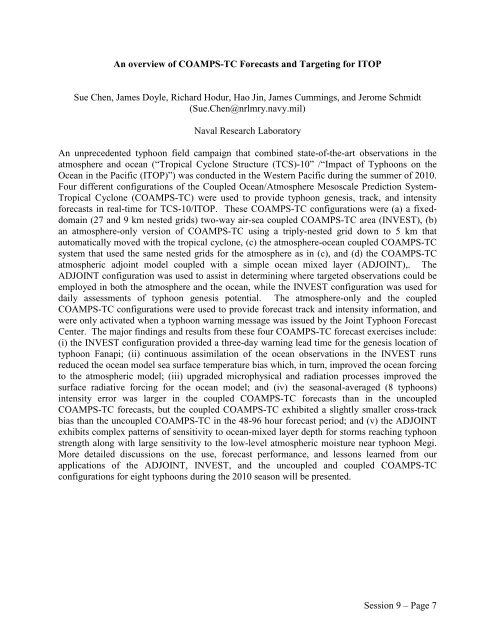65th IHC Booklet/Program (pdf - 4.9MB) - Office of the Federal ...
65th IHC Booklet/Program (pdf - 4.9MB) - Office of the Federal ...
65th IHC Booklet/Program (pdf - 4.9MB) - Office of the Federal ...
You also want an ePaper? Increase the reach of your titles
YUMPU automatically turns print PDFs into web optimized ePapers that Google loves.
An overview <strong>of</strong> COAMPS-TC Forecasts and Targeting for ITOP<br />
Sue Chen, James Doyle, Richard Hodur, Hao Jin, James Cummings, and Jerome Schmidt<br />
(Sue.Chen@nrlmry.navy.mil)<br />
Naval Research Laboratory<br />
An unprecedented typhoon field campaign that combined state-<strong>of</strong>-<strong>the</strong>-art observations in <strong>the</strong><br />
atmosphere and ocean (“Tropical Cyclone Structure (TCS)-10” /“Impact <strong>of</strong> Typhoons on <strong>the</strong><br />
Ocean in <strong>the</strong> Pacific (ITOP)”) was conducted in <strong>the</strong> Western Pacific during <strong>the</strong> summer <strong>of</strong> 2010.<br />
Four different configurations <strong>of</strong> <strong>the</strong> Coupled Ocean/Atmosphere Mesoscale Prediction System-<br />
Tropical Cyclone (COAMPS-TC) were used to provide typhoon genesis, track, and intensity<br />
forecasts in real-time for TCS-10/ITOP. These COAMPS-TC configurations were (a) a fixeddomain<br />
(27 and 9 km nested grids) two-way air-sea coupled COAMPS-TC area (INVEST), (b)<br />
an atmosphere-only version <strong>of</strong> COAMPS-TC using a triply-nested grid down to 5 km that<br />
automatically moved with <strong>the</strong> tropical cyclone, (c) <strong>the</strong> atmosphere-ocean coupled COAMPS-TC<br />
system that used <strong>the</strong> same nested grids for <strong>the</strong> atmosphere as in (c), and (d) <strong>the</strong> COAMPS-TC<br />
atmospheric adjoint model coupled with a simple ocean mixed layer (ADJOINT),. The<br />
ADJOINT configuration was used to assist in determining where targeted observations could be<br />
employed in both <strong>the</strong> atmosphere and <strong>the</strong> ocean, while <strong>the</strong> INVEST configuration was used for<br />
daily assessments <strong>of</strong> typhoon genesis potential. The atmosphere-only and <strong>the</strong> coupled<br />
COAMPS-TC configurations were used to provide forecast track and intensity information, and<br />
were only activated when a typhoon warning message was issued by <strong>the</strong> Joint Typhoon Forecast<br />
Center. The major findings and results from <strong>the</strong>se four COAMPS-TC forecast exercises include:<br />
(i) <strong>the</strong> INVEST configuration provided a three-day warning lead time for <strong>the</strong> genesis location <strong>of</strong><br />
typhoon Fanapi; (ii) continuous assimilation <strong>of</strong> <strong>the</strong> ocean observations in <strong>the</strong> INVEST runs<br />
reduced <strong>the</strong> ocean model sea surface temperature bias which, in turn, improved <strong>the</strong> ocean forcing<br />
to <strong>the</strong> atmospheric model; (iii) upgraded microphysical and radiation processes improved <strong>the</strong><br />
surface radiative forcing for <strong>the</strong> ocean model; and (iv) <strong>the</strong> seasonal-averaged (8 typhoons)<br />
intensity error was larger in <strong>the</strong> coupled COAMPS-TC forecasts than in <strong>the</strong> uncoupled<br />
COAMPS-TC forecasts, but <strong>the</strong> coupled COAMPS-TC exhibited a slightly smaller cross-track<br />
bias than <strong>the</strong> uncoupled COAMPS-TC in <strong>the</strong> 48-96 hour forecast period; and (v) <strong>the</strong> ADJOINT<br />
exhibits complex patterns <strong>of</strong> sensitivity to ocean-mixed layer depth for storms reaching typhoon<br />
strength along with large sensitivity to <strong>the</strong> low-level atmospheric moisture near typhoon Megi.<br />
More detailed discussions on <strong>the</strong> use, forecast performance, and lessons learned from our<br />
applications <strong>of</strong> <strong>the</strong> ADJOINT, INVEST, and <strong>the</strong> uncoupled and coupled COAMPS-TC<br />
configurations for eight typhoons during <strong>the</strong> 2010 season will be presented.<br />
Session 9 – Page 7
















